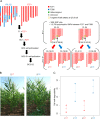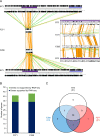A systems biology approach uncovers a gene co-expression network associated with cell wall degradability in maize
- PMID: 31891625
- PMCID: PMC6938352
- DOI: 10.1371/journal.pone.0227011
A systems biology approach uncovers a gene co-expression network associated with cell wall degradability in maize
Abstract
Understanding the mechanisms triggering variation of cell wall degradability is a prerequisite to improving the energy value of lignocellulosic biomass for animal feed or biorefinery. Here, we implemented a multiscale systems approach to shed light on the genetic basis of cell wall degradability in maize. We demonstrated that allele replacement in two pairs of near-isogenic lines at a region encompassing a major quantitative trait locus (QTL) for cell wall degradability led to phenotypic variation of a similar magnitude and sign to that expected from a QTL analysis of cell wall degradability in the F271 × F288 recombinant inbred line progeny. Using DNA sequences within the QTL interval of both F271 and F288 inbred lines and Illumina RNA sequencing datasets from internodes of the selected near-isogenic lines, we annotated the genes present in the QTL interval and provided evidence that allelic variation at the introgressed QTL region gives rise to coordinated changes in gene expression. The identification of a gene co-expression network associated with cell wall-related trait variation revealed that the favorable F288 alleles exploit biological processes related to oxidation-reduction, regulation of hydrogen peroxide metabolism, protein folding and hormone responses. Nested in modules of co-expressed genes, potential new cell-wall regulators were identified, including two transcription factors of the group VII ethylene response factor family, that could be exploited to fine-tune cell wall degradability. Overall, these findings provide new insights into the regulatory mechanisms by which a major locus influences cell wall degradability, paving the way for its map-based cloning in maize.
Conflict of interest statement
The authors have declared that no competing interests exist.
Figures





References
-
- Barrière Y. Brown-midrib genes in maize and their efficiency in dairy cow feeding. Perspectives for breeding improved silage maize targeting gene modifications in the monolignol and p-hydroxycinnamate pathways. Maydica. 2017;62: 1–19.
-
- Barrière Y, Emile JC, Traineau R, Surault F, Briand M, Gallais A. Genetic variation for organic matter and cell wall digestibility in silage maize. Lessons from a 34-year long experiment with sheep in digestibility crates. Maydica. 2004;49: 115–126.
-
- Zhao X, Zhang L, Liu D. Biomass recalcitrance. Part I: The chemical compositions and physical structures affecting the enzymatic hydrolysis of lignocellulose. Biofuels Bioproducts and Biorefining. 2012;6: 465–482.
Publication types
MeSH terms
Substances
LinkOut - more resources
Full Text Sources
Molecular Biology Databases

